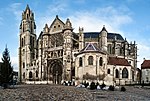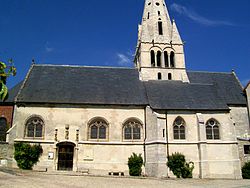Senlis Cathedral

Senlis Cathedral (French: Cathédrale Notre-Dame de Senlis) is a Roman Catholic church and former cathedral in Senlis, Oise, France. It was formerly the seat of the Bishopric of Senlis, abolished under the Concordat of 1801, when its territory was passed to the Diocese of Beauvais. Notre-Dame Cathedral was built, for the most part, during the third quarter of the 12th century, when the royal city of Senlis was experiencing a true "golden age". It was profoundly renovated in the 13th and 16th centuries. With its portal of the crowning of the Virgin (12th century), its monumental 78 meter south tower (13th century) and transept facades all masterpieces of the high and late Gothic, Notre Dame de Senlis takes its place among the most noticeable cathedrals in France. This is better demonstrated as the cathedral of Senlis was included in the first list of historical monuments in 1840.
Excerpt from the Wikipedia article Senlis Cathedral (License: CC BY-SA 3.0, Authors, Images).Senlis Cathedral
Place Notre-Dame, Senlis
Geographical coordinates (GPS) Address Phone number External links Nearby Places Show on map
Geographical coordinates (GPS)
| Latitude | Longitude |
|---|---|
| N 49.206805555556 ° | E 2.5859722222222 ° |
Address
Cathédrale Notre-Dame
Place Notre-Dame
60300 Senlis
Hauts-de-France, France
Open on Google Maps








